Simple and Robust Boolean Operations for Triangulated Surfaces †
Abstract
1. Introduction
- (1)
- An octree-based method for locating and searching possible intersecting triangle pairs is proposed, and a parallel algorithm is used to calculate the intersection lines of candidate intersecting triangle pairs.
- (2)
- An entity index-based method is proposed to obtain intersection rings of triangular surfaces, create sub-surfaces and sub-blocks, and distinguish between merging, intersecting, and subtracting volumes of two intersecting surfaces.
- (3)
- Through these techniques, we reduce computational effort, enhance robustness, and cater to a wide range of triangulated surface Boolean operations.
2. The Proposed Method
2.1. Overview
2.2. Data Structure and Notation
2.3. Details of the Proposed Method
2.3.1. Searching Intersected Triangle Pairs
- (1)
- The depth of the node reaches a user-specified maximum depth;
- (2)
- Both N and N less than a given allowable number;
- (3)
- N or N is zero.
2.3.2. Intersecting of Triangles and Re-Triangulating
#pragma omp parallel forfor each pair of triangles {Calculate the intersection of ;Save the intersection edge of if it exists;}
2.3.3. Merging and Updating
- (1)
- All vertices are merged and renumbered;
- (2)
- The vertex indexes are updated for each triangle and loop;
- (3)
- Each triangle and loop are checked to identify if there are any vertices with the same index;
- (4)
- The newly generated triangles are reversed (Figure 3).
2.3.4. Forming Intersection Loops
2.3.5. Creating Sub-Surfaces
| Algorithm 1 Create Sub-surfaces from Closed Loops |
|
2.3.6. Assembling and Distinguishing Sub-Blocks
- (1)
- Assembling All Possible Sub-Blocks
| Algorithm 2 Create Sub-blocks From Sub-surfaces |
|
- (2)
- Distinguishing
3. Results
4. Discussion
4.1. Comparative Analysis with Other Methods
4.1.1. Advantages of the Proposed Algorithm
4.1.2. Disadvantages of the Proposed Algorithm
4.2. Outlook and Future Work
5. Conclusions
Author Contributions
Funding
Institutional Review Board Statement
Informed Consent Statement
Data Availability Statement
Acknowledgments
Conflicts of Interest
Abbreviations
| B-Rep | Boundary Representation |
| NURBS | Non-uniform Rational Basis Spline |
| BSP | Binary Space Partitions |
| OBB | Oriented Bounding Box |
| CGAL | Computational Geometry Algorithms Library |
| GPU | Graphics Processing Unit |
| AABB | Axially Aligned Bounding Box |
| CCW | Counter-Clockwise |
| CW | Clockwise |
References
- Hoffmann, C. Geometric and Solid Modeling; Morgan Kaufmann: San Mateo, CA, USA, 1989. [Google Scholar]
- Xu, N.; Tian, H. Wire frame: A reliable approach to build sealed engineering geological models. Comput. Geosci. 2009, 35, 1582–1591. [Google Scholar] [CrossRef]
- Young, G. Multi-Level Voxel Representation for GPU-Accelerated Solid Modeling. Ph.D. Thesis, Iowa State University, Ames, IA, USA, 2017. [Google Scholar]
- Zaharescu, A.; Boyer, E.; Horaud, R. Topology-adaptive mesh deformation for surface evolution, morphing, and multiview reconstruction. IEEE Trans. Pattern Anal. Mach. Intell. 2011, 33, 823–837. [Google Scholar] [CrossRef]
- Li, Z.; Shan, J. RANSAC-based multi primitive building reconstruction from 3D point clouds. ISPRS J. Photogramm. Remote Sens. 2022, 185, 247–260. [Google Scholar] [CrossRef]
- Yin, G.; Xiao, X.; Cirak, F. Topologically robust CAD model generation for structural optimisation. Comput. Methods Appl. Mech. Eng. 2020, 369, 113102. [Google Scholar] [CrossRef]
- Li, B.; Shen, C. Solid Stress-Distribution-Oriented Design and Topology Optimization of 3D-Printed Heterogeneous Lattice Structures with Light Weight and High Specific Rigidity. Polymers 2022, 14, 2807. [Google Scholar] [CrossRef]
- Sharma, V.; Tripathi, A.K.; Mittal, H.; Parmar, A.; Soni, A.; Amarwal, R. WeedGan: A novel generative adversarial network for cotton weed identification. Vis. Comput. 2022. [Google Scholar] [CrossRef]
- Sharma, V.; Tripathi, A.K.; Mittal, H. Technological Advancements in Automated Crop Pest and Disease Detection: A Review & Ongoing Research. In Proceedings of the 2022 International Conference on Computing, Communication, Security and Intelligent Systems (IC3SIS), Kochi, India, 23–25 June 2022; pp. 1–6. [Google Scholar] [CrossRef]
- Sharma, V.; Tripathi, A.K.; Mittal, H. DLMC-Net: Deeper lightweight multi-class classification model for plant leaf disease detection. Ecol. Inform. 2023, 75, 102025. [Google Scholar] [CrossRef]
- Sharma, G.; Goyal, R.; Liu, D.; Kalogerakis, E.; Maji, S. Neural Shape Parsers for Constructive Solid Geometry. IEEE Trans. Pattern Anal. Mach. Intell. 2022, 44, 2628–2640. [Google Scholar] [CrossRef]
- Wu, C.T.; Yang, Y.H.; Chang, Y.Z. Three-dimensional deep learning to automatically generate cranial implant geometry. Sci. Rep. 2022, 12, 2683. [Google Scholar] [CrossRef]
- Sharma, V.; Tripathi, A.K. A systematic review of meta-heuristic algorithms in IoT based application. Array 2022, 14, 100164. [Google Scholar] [CrossRef]
- Sharma, V.; Tripathi, A.K.; Mittal, H. Technological revolutions in smart farming: Current trends, challenges & future directions. Comput. Electron. Agric. 2022, 201, 107217. [Google Scholar] [CrossRef]
- Pavic, D.; Campen, M.; Kobbelt, L. Hybrid booleans. Comput. Graph. Forum 2010, 29, 75–87. [Google Scholar] [CrossRef]
- Tayebi, A.; Gómez Pérez, J.; González, D.I.; Cátedra, F. Boolean operations implementation over 3D parametric surfaces to be included in the geometrical module of an electromagnetic solver. In Proceedings of the 5th European Conference on Antennas and Propagation (EUCAP), Rome, Italy, 11–15 April 2011; pp. 2137–2141. [Google Scholar]
- Yang, P.; Qian, X. Direct boolean intersection between acquired and designed geometry. Comput.-Aided Des. 2009, 41, 81–94. [Google Scholar] [CrossRef]
- Lo, S.; Wang, W. Finite element mesh generation over intersecting curved surfaces by tracing of neighbours. Finite Elem. Anal. Des. 2005, 41, 351–370. [Google Scholar] [CrossRef]
- Campen, M.; Kobbelt, L. Exact and robust (self-)intersections for polygonal meshes. Comput. Graph. Forum 2010, 29, 397–406. [Google Scholar] [CrossRef]
- Schifko, M.; Juttler, B.; Kornberger, B. Industrial application of exact Boolean operations for meshes. In Proceedings of the 26th Spring Conference on Computer Graphics, Budmerice, Slovakia, 13–15 May 2010; pp. 165–172. [Google Scholar]
- Pereira, A.; de Arruda, M.; Miranda, A.; Lira, W.; Martha, L. Boolean operations on multi-region solids for mesh generation. Eng. Comput. 2011, 28, 225–239. [Google Scholar] [CrossRef]
- Smith, J.; Dodgson, N. A topologically robust algorithm for Boolean operations on polyhedral shapes using approximate arithmetic. Comput.-Aided Des. 2007, 39, 149–163. [Google Scholar] [CrossRef]
- Chen, Y. Robust and accurate boolean operations on polygonal models. In Proceedings of the DETC’07, Las Vegas, NV, USA, 4–7 September 2007. [Google Scholar]
- Wang, C. Approximate Boolean operations on large polyhedral solids with partial mesh reconstruction. IEEE Trans. Vis. Comput. Graph. 2011, 17, 836–849. [Google Scholar] [CrossRef] [PubMed]
- Jing, Y.; Wang, L.; Bi, L.; Chen, J. Boolean Operations on Polygonal Meshes Using OBB Trees. In Proceedings of the International Conference on Environmental Science and Information Application Technology, Wuhan, China, 4–5 July 2009; pp. 619–622. [Google Scholar]
- Severn, A.; Samavati, F. Fast intersections for subdivision surfaces. In Proceedings of the 6th International Conference on Computational Science and Its Applications, Glasgow, UK, 8–11 May 2006; pp. 91–100. [Google Scholar]
- Guo, K.; Zhang, L.; Wang, C. Boolean operations of STL models based on loop detection. Int. J. Adv. Manuf. Technol. 2007, 33, 627–633. [Google Scholar] [CrossRef]
- Chen, M.; Chen, X.; Tang, K.; Yuen, M. Efficient boolean operation on manifold mesh surfaces. Comput.-Aided Des. Appl. 2010, 7, 405–415. [Google Scholar] [CrossRef]
- Landier, S. Boolean operations on arbitrary polygonal and polyhedral meshes. Comput.-Aided Des. 2017, 85, 138–153. [Google Scholar] [CrossRef]
- Milenkovic, V.; Sacks, E. Geometric rounding and feature separation in meshese. Comput.-Aided Des. 2019, 108, 12–18. [Google Scholar] [CrossRef]
- Hu, Y.; Schneider, T.; Wang, B.; Zorin, D.; Panozzo, D. Fast Tetrahedral Meshing in the Wild. ACM Trans. Graph. 2020, 39, 117. [Google Scholar] [CrossRef]
- Hu, Y.; Zhou, Q.; Gao, X.; Jacobson, A.; Zorin, D.; Panozzo, D. Tetrahedral Meshing in the Wild. ACM Trans. Graph. 2018, 37, 60. [Google Scholar] [CrossRef]
- Cherchi, G.; Pellacini, F.; Attene, M.; Livesu, M. Interactive and Robust Mesh Booleans. ACM Trans. Graph. 2022, 41, 248. [Google Scholar] [CrossRef]
- Mei, G.; Tipper, J.C. Simple and robust boolean operations for triangulated surfaces. arXiv 2013, arXiv:1308.4434. [Google Scholar]
- Trettner, P.; Nehring-Wirxel, J.; Kobbelt, L. EMBER: Exact Mesh Booleans via Efficient & Robust Local Arrangements. ACM Trans. Graph. 2022, 41, 39. [Google Scholar] [CrossRef]
- Nehring-Wirxel, J.; Trettner, P.; Kobbelt, L. Fast Exact Booleans for Iterated CSG using Octree-Embedded BSPs. Comput.-Aided Des. 2021, 135, 103015. [Google Scholar] [CrossRef]
- Attene, M. Indirect Predicates for Geometric Constructions. Comput.-Aided Des. 2020, 126, 102856. [Google Scholar] [CrossRef]
- Diazzi, L.; Attene, M. Convex polyhedral meshing for robust solid modeling. ACM Trans. Graph. 2021, 40, 259. [Google Scholar] [CrossRef]
- Feito, F.R.; Ogayar, C.J.; Segura, R.J.; Rivero, M.L. Fast and accurate evaluation of regularized Boolean operations on triangulated solids. Comput.-Aided Des. 2013, 45, 705–716. [Google Scholar] [CrossRef]
- Gao, Y.; Luo, J.; Hangping, Q.; Tang, B.; Wu, B.; Duan, W. A GPU-based rasterization algorithm for boolean operations on polygons. IEICE Trans. Inf. Syst. 2018, E101D, 234–238. [Google Scholar] [CrossRef]
- Qin, Y.; Luo, Z.; Wen, L.; Feng, C.; Zhang, X.; Lan, M.; Liu, B. Research and application of Boolean operation for triangular mesh model of underground space engineering—Boolean operation for triangular mesh model. Energy Sci. Eng. 2019, 7, 1154–1165. [Google Scholar] [CrossRef]
- Wang, H.; Kan, S.; Zhang, X.; Lu, X.; Zhou, L. Robust Boolean operations algorithm on regularized triangular mesh and implementation. Multimed. Tools Appl. 2018, 79, 5301–5320. [Google Scholar] [CrossRef]
- The CGAL Project. 2012. Available online: http://www.cgal.org/ (accessed on 1 June 2013).
- Cignoni, P.; Callieri, M.; Corsini, M. MeshLab: An open-source mesh processing tool. In Proceedings of the 6th Eurographics Italian Chapter Conference, Salerno, Italy, 2–4 July 2008. [Google Scholar]
- Mobius, J.; Kobbelt, L. OpenFlipper: An open source geometry processing and rendering framework. In Proceedings of the 7th International Conference on Curves and Surfaces, Avignon, France, 24–30 June 2010; pp. 488–500. [Google Scholar]
- Lavoue, G.; Tola, M.; Dupont, F. MEPP-3D mesh processing platform. In Proceedings of the International Conference on Computer Graphics Theory and Applications(GRAPP), Rome, Italy, 24–26 February 2012. [Google Scholar]
- Ericson, C. The Internet of Things: A Survey; Morgan Kaufmann: San Francisco, CA, USA, 2005. [Google Scholar]
- Moller, T. A fast triangle-triangle intersection test. J. Graph. Tools 1997, 2, 25–30. [Google Scholar] [CrossRef]
- OpenMP. Available online: http://www.openmp.org/ (accessed on 1 June 2013).
- Held, M. FIST: Fast industrial-strength triangulation of polygons. Algorithmica 2001, 30, 563–596. [Google Scholar] [CrossRef]
- Riso, M.; Nazzaro, G.; Puppo, E.; Jacobson, A.; Zhou, Q.; Pellacini, F. BoolSurf: Boolean Operations on Surfaces. ACM Trans. Graph. 2022, 41, 247. [Google Scholar] [CrossRef]
- Wang, B.; Mei, G.; Xu, N. Method for generating high-quality tetrahedral meshes of geological models by utilizing CGAL. MethodsX 2020, 7, 101061. [Google Scholar] [CrossRef] [PubMed]
- Hachenberger, P.; Kettner, L.; Mehlhorn, K. Boolean operations on 3D selective Nef complexes: Data structure, algorithms, optimized implementation and experiments. Comput. Geom. 2007, 38, 64–99. [Google Scholar] [CrossRef]
- Xiao, L.; Mei, G.; Cuomo, S.; Xu, N. Comparative investigation of GPU-accelerated triangle-triangle intersection algorithms for collision detection. Multimed. Tools Appl. 2020, 8, 3165–3180. [Google Scholar] [CrossRef]
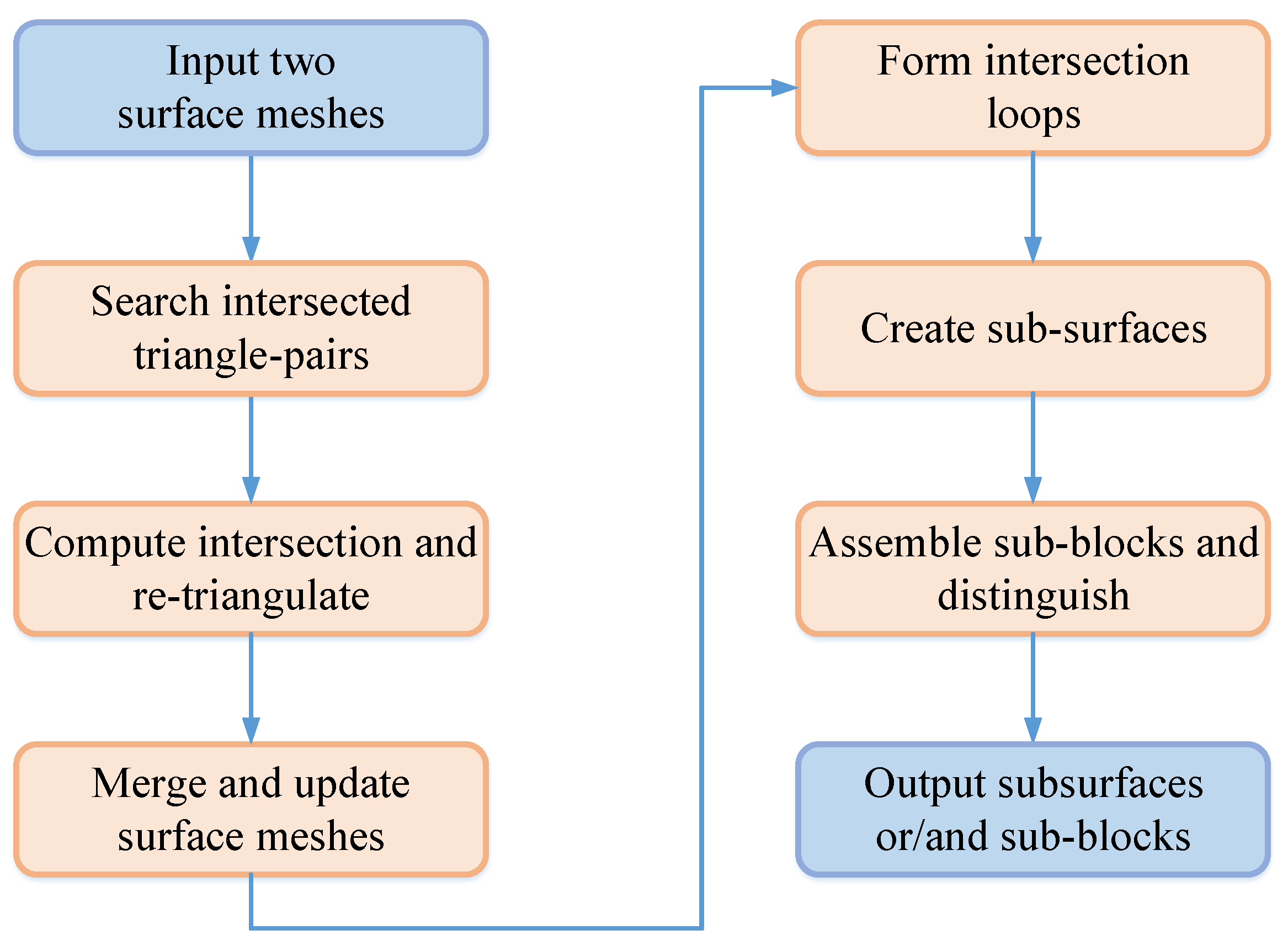





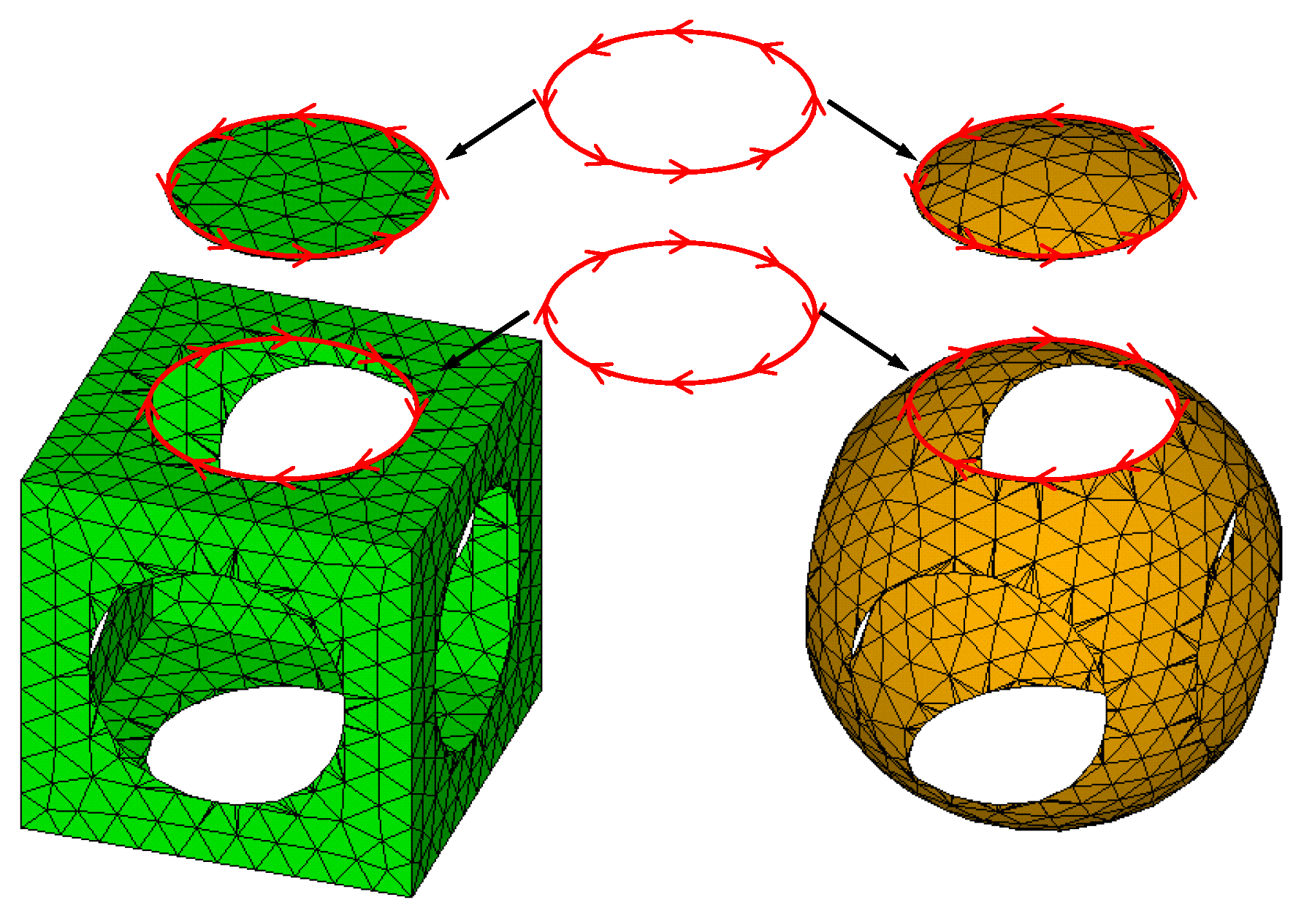
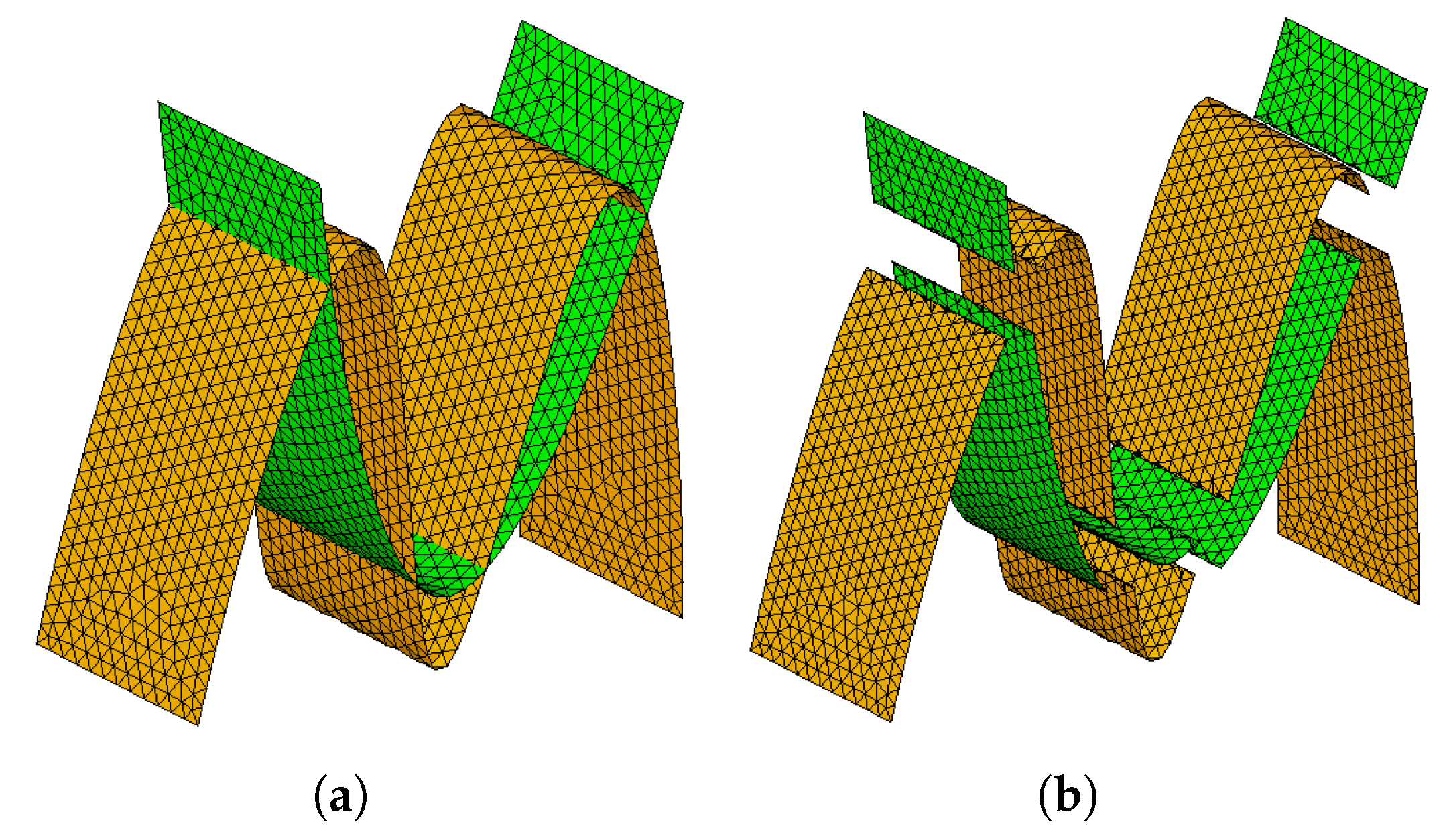

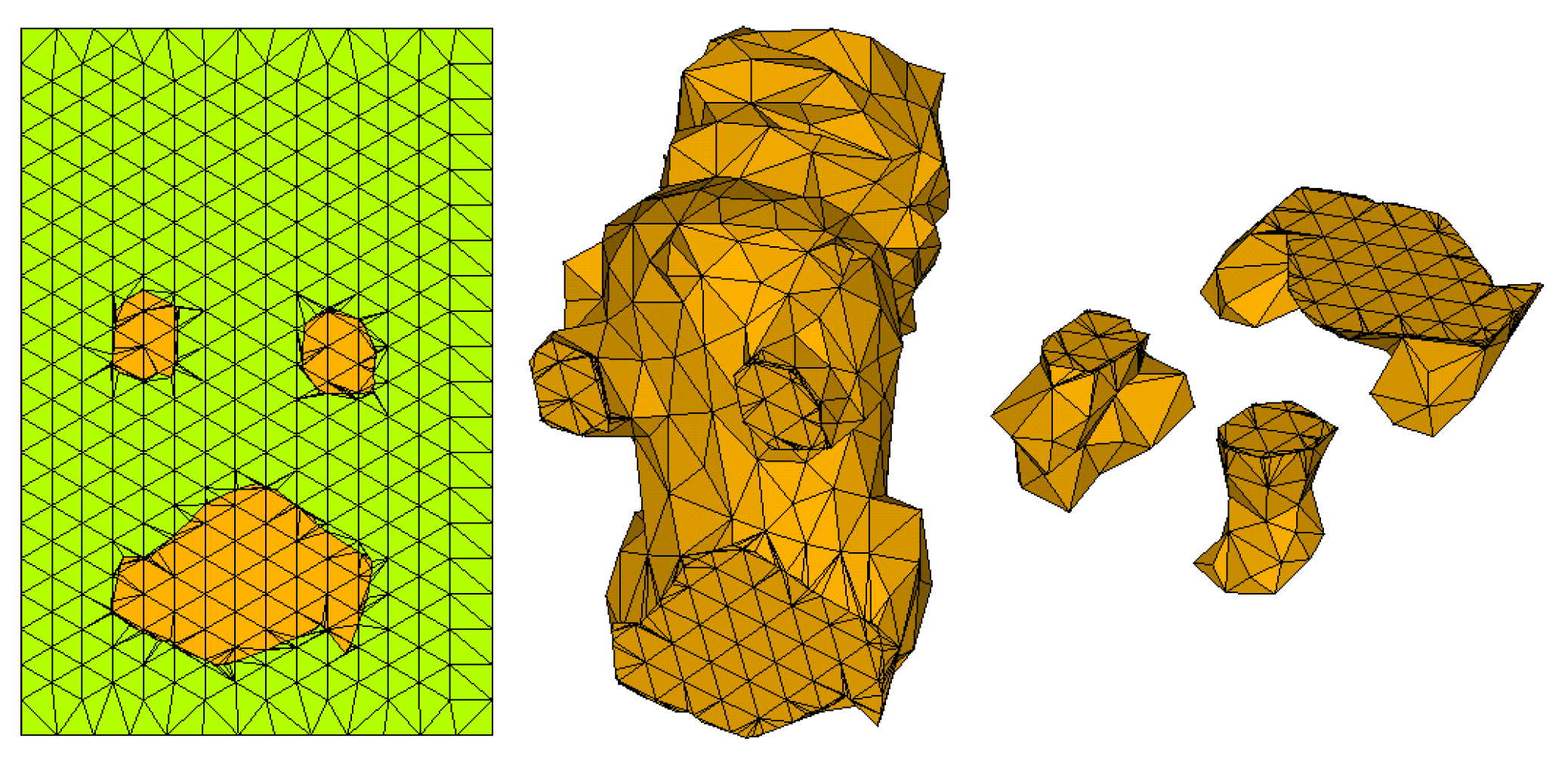

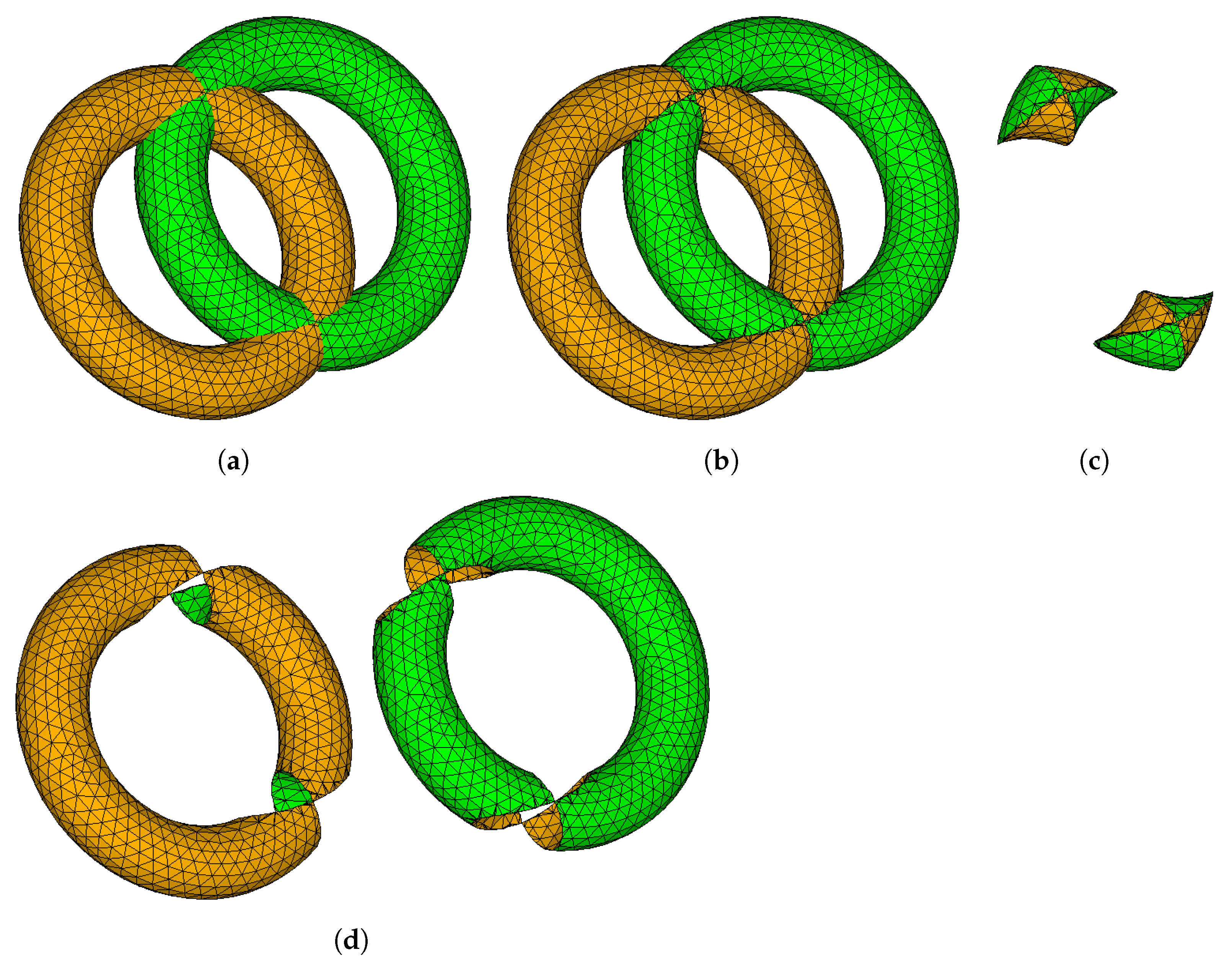
Disclaimer/Publisher’s Note: The statements, opinions and data contained in all publications are solely those of the individual author(s) and contributor(s) and not of MDPI and/or the editor(s). MDPI and/or the editor(s) disclaim responsibility for any injury to people or property resulting from any ideas, methods, instructions or products referred to in the content. |
© 2023 by the authors. Licensee MDPI, Basel, Switzerland. This article is an open access article distributed under the terms and conditions of the Creative Commons Attribution (CC BY) license (https://creativecommons.org/licenses/by/4.0/).
Share and Cite
Zhou, M.; Qin, J.; Mei, G.; Tipper, J.C. Simple and Robust Boolean Operations for Triangulated Surfaces. Mathematics 2023, 11, 2713. https://doi.org/10.3390/math11122713
Zhou M, Qin J, Mei G, Tipper JC. Simple and Robust Boolean Operations for Triangulated Surfaces. Mathematics. 2023; 11(12):2713. https://doi.org/10.3390/math11122713
Chicago/Turabian StyleZhou, Meijun, Jiayu Qin, Gang Mei, and John C. Tipper. 2023. "Simple and Robust Boolean Operations for Triangulated Surfaces" Mathematics 11, no. 12: 2713. https://doi.org/10.3390/math11122713
APA StyleZhou, M., Qin, J., Mei, G., & Tipper, J. C. (2023). Simple and Robust Boolean Operations for Triangulated Surfaces. Mathematics, 11(12), 2713. https://doi.org/10.3390/math11122713






